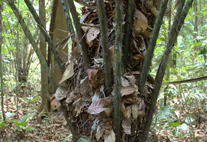High land carbon losses due to extreme assumptions
1 December 2015, by CEN Universität Hamburg

Photo: brovkin
Victor Brovkin and Daniel Goll comment in Nature Geoscience on a recently published paper by Wieder et al.
Prof. Victor Brovkin from the Universität Hamburg and the Max Planck Institute for Meteorology (MPI-M) and Dr. Daniel Goll comment in Nature Geoscience on a recently published paper by Wieder et al. (2015).
Wieder et al. argue that the Earth System models used in the CMIP5 (Coupled Model Intercomparison Project Phase 5) significantly overestimate future land carbon uptake. They conclude that the nutrient limitation of ecosystems could turn terrestrial ecosystems from being a net carbon sink to a large carbon source by the end of the 21st century. Brovkin and Goll disagree with this finding, because many processes, which could increase nutrient availability for ecosystems, were not accounted in the study by Wieder et al.
Background: increasing CO2 concentration and rising temperatures are both expected to have important impacts on plant productivity. It is likely that the higher CO2 concentration will enhance plant growth and, consequently, elevate land carbon uptake. However, models used to simulate how terrestrial carbon stocks change in response to climate change, such as CMIP5 models, do not account for how changes in the availability of nutrients such as nitrogen or phosphorus may limit net primary production.
Warning messages should not be based on extreme assumptions
Wieder et al. assume that warming stimulates decomposition of soil organic carbon but does not affect the mineralization of nutrients from soil organic matter. This assumption maximizes the effect of nutrient limitation on land carbon storage under warming. It contradicts soil-warming experiments showing enhanced mineralization in a range of ecosystems, which potentially compensates soil carbon losses by stimulating plant productivity due to increased nutrient availability.
Changes in mineralization, as well as additional processes governing the recycling of nutrients, poses a large source of uncertainty in the amount of nutrient available for the buildup of new biomass. Wieder et al. assume that changes in external supplies of phosphorus, such as weathering, is the only source of phosphorus available for plant biomass increase. Observations, however, show that external supplies are of minor importance for the terrestrial carbon balance. Therefore, it is incorrect to neglect changes in internal recycling of phosphorus, for example, due to redistribution of mineralized phosphorus in soils.
Currently, land ecosystems absorb a quarter of anthropogenic CO2 emissions. Potential turning of this sink into a source conveys a strong warning message to policymakers. It should not be based on extreme assumptions on nutrient dynamics in ecosystems and upper-end warming scenarios only.
Publications:
Brovkin, V., and D. Goll (2015): Land unlikely to become large carbon source. Nature Geoscience, 8, 893, doi:10.1038/ngeo2598
Wieder, W.R., C.C. Cleveland, W.K. Smith, and K. Todd-brown (2015): Future productivity and carbon storage limited by terrestrial nutrient availability. Nature Geoscience, 8, 441–444, doi:10.1038/ngeo2413
Goll, D. S., Brovkin, V., Parida, B. R., Reick, C. H., Kattge, J., Reich, P. B., van Bodegom, P. M., & Niinemets, Ü (2012).: Nutrient limitation reduces land carbon uptake in simulations with a model of combined carbon, nitrogen and phosphorus cycling, Biogeosciences, 9, 3547-3569. doi:10.5194/bg-9-3547-2012
Contact:
Prof. Dr. Victor Brovkin, Universität Hamburg
Max Planck Institute for Meteorology
Phone: +49 (0) 40 41173 339
Email: victor.brovkin"AT"mpimet.mpg.de
